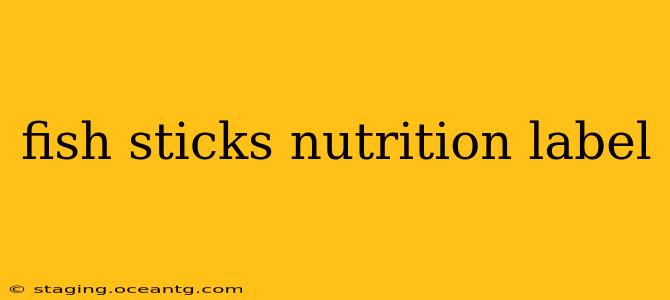Fish sticks, a convenient and often beloved childhood favorite, are a staple in many freezers. But how nutritious are they really? Understanding the nutrition label is key to making informed choices about this popular food. This guide will break down the typical components of a fish stick nutrition label, address common questions, and help you navigate the sometimes-confusing world of processed food nutrition.
What's Typically on a Fish Stick Nutrition Label?
A standard fish stick nutrition label will generally include the following information per serving:
-
Serving Size: This indicates the amount of fish sticks considered one serving. It's crucial to pay attention to this, as the entire nutritional information is based on this single serving size. Multiple servings will multiply the calories, fats, and other nutrients.
-
Calories: This shows the total energy provided by the serving. Calories from fat will often be specified separately.
-
Total Fat: This includes all types of fat, saturated and unsaturated. Saturated fat is often highlighted because it's associated with increased cholesterol levels.
-
Cholesterol: Fish sticks often contain some cholesterol, although the amount varies based on the type of fish and preparation methods.
-
Sodium: This is often a significant component of fish sticks, due to the breading and processing. High sodium intake can contribute to high blood pressure.
-
Total Carbohydrate: This includes sugars, dietary fiber, and other carbohydrates. The amount of sugars will be specified separately.
-
Dietary Fiber: This refers to the indigestible part of carbohydrates that promotes healthy digestion. Fish sticks typically have a low amount of dietary fiber.
-
Total Sugars: This indicates the amount of added and naturally occurring sugars in the serving.
-
Protein: Fish is a good source of protein, and the label will reflect the amount of protein per serving.
-
Vitamins and Minerals: Some fish sticks may be fortified with vitamins and minerals, such as Vitamin A, Vitamin D, and Calcium. These will be listed, but the amounts are often minimal.
How Many Calories are in Fish Sticks?
The calorie count in fish sticks varies significantly based on brand, serving size, and preparation method. A typical serving might range from 100 to 200 calories, but always check the specific label for the most accurate information. Larger servings or breaded varieties will naturally have more calories.
Are Fish Sticks Healthy?
Whether or not fish sticks are "healthy" is a complex question. They offer a source of protein, and some brands may add vitamins and minerals. However, they are often high in sodium and unhealthy fats. Moderation is key, and selecting brands with lower sodium and saturated fat content is advisable.
What are the Ingredients in Fish Sticks?
Ingredients vary depending on the brand, but commonly include fish (often pollock or cod), breading (flour, cornmeal, spices), and various additives like preservatives and flavor enhancers. Always check the ingredient list for any potential allergens or additives you wish to avoid.
Are There Healthier Alternatives to Fish Sticks?
Yes, there are many healthier alternatives to commercially produced fish sticks. Baking your own fish sticks with whole-wheat breading and reduced sodium can significantly improve the nutritional profile. Other healthy options include baked or grilled fish fillets, fish cakes made with fresh ingredients, or fish patties with minimal added fat and sodium.
How Can I Make Healthier Fish Stick Choices?
To make healthier fish stick choices, consider:
- Checking Nutrition Labels Carefully: Pay close attention to serving size, sodium content, and saturated fat.
- Comparing Brands: Compare nutrition labels from different brands to find options with lower sodium and saturated fat.
- Portion Control: Stick to the recommended serving size.
- Preparation Methods: Consider baking fish sticks instead of frying them to reduce fat intake.
By understanding the information provided on a fish stick nutrition label and making informed choices, you can enjoy this convenient food while being mindful of your overall health and nutritional needs. Remember, moderation and mindful selection are key to enjoying any processed food as part of a balanced diet.
